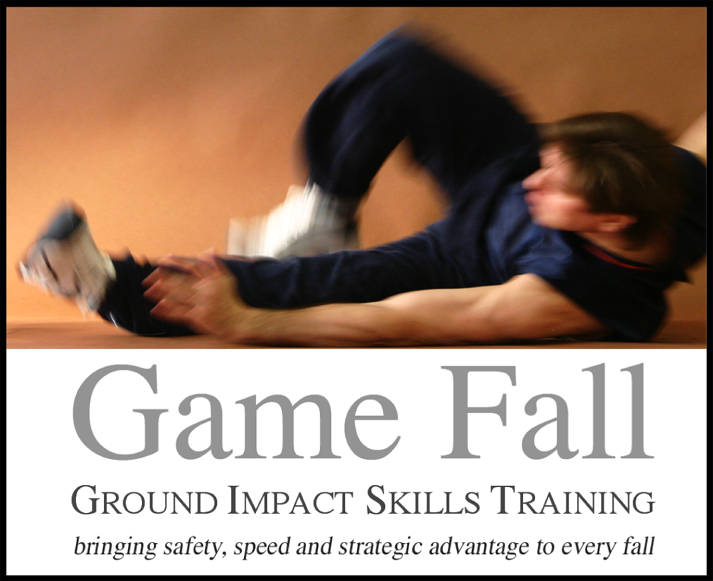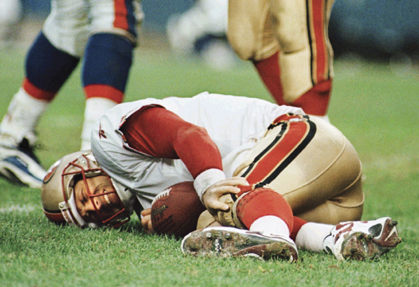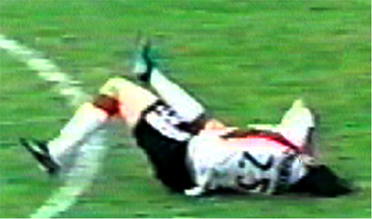 |
"It
is not Falling that causes injury. It is Not Knowing How to Fall that
causes injury." |
||||||
|
 |
"It
is not Falling that causes injury. It is Not Knowing How to Fall that
causes injury." |
||||||
|

Ground Impact Questions
Game Safe Falling Program Questions
What is the Game Safe Falling program designed to do?
What exactly are you going to teach me?
Falling hurts, so why won't learning how to fall hurt?
How long does it take to learn these new falling skills?
How does this work? Do I go to you, or do you come to me? How do you schedule the trainings?
Do I need any special equipment, special practice surfaces?
Once I learn Dynamic Falling, how will I remember during competition to use it ?
After I complete the training, do you provide any further instruction or support?
What else is included in the program?
Targeted Injury Prevention Questions?
The 360° Hip Stretching and Explosive Power Training, do they have to be done everyday to be effective?
What is wrong with how I already stretch? It's been working for me for years.
How does 360° Hip Stretching fill in the missing stretches?
Game Fall Questions
Who is Game Fall? Why and how did it tackle the problem of Hard Falling?
Ground Impact Questions
Why should I worry about falling - when you fall, you just fall, and when you land, you just land, right?
When you fall you instinctively react, you don't just fall and land - your body reacts to losing its balance. Almost instantly your body changes its position to move your head as far away from the ground as possible. As far as your falling instinct is concerned, the rest of your body is to stiffen, square up and take the full power of the fall's force to keep your head safe. (Further explanation.)
There is a way to protect both your head and your body in a fall - the Dynamic Falling Method.
I am an athlete and have been falling for years. I know how to slide and roll and do a pretty good job of not getting hurt. Why do I need new falling skills?
The falling techniques athletes and youths know are important and useful, but athletes and youths are still getting hurt in falls. Sport falls are fast, carry a lot of force and come at a multitude of angles. Falling while running, for example, has the same force as falling face first off a desk or high step-ladder.
When they can, athletes and youths barrel roll or slide along their chest, hip or rear to spread the fall's force out along the ground. To fall over distance instead of straight down is the right approach; however, barrel rolls are more angular than most people realize and are both inefficient at dispersing impact energy and a bit dangerous. Slides have their own failings - they let great amounts of impact force straight into the torso, neck and head, and they let the head slam into the ground on the harder falls. Worse still, athletes and youths twist while falling to set up for a barrel roll or slide, but when they don't make it (which happens often), they end up hitting the ground even harder.
New falling techniques that always disperse high impact energy would go a long way to helping athletes and youths stay healthy and in the game.
The head looks low to the ground in some of your pictures, isn't that more dangerous than what I do now?
When falling, your head always ends up close to the ground - usually just staying a few inches above it; which means your head is always at risk of getting kicked during a fall. The longer your head is near the ground, the longer it is at risk.
Right now, on average, your head will be in this low-to-the-ground danger zone for about four seconds every time you fall. With Game Fall's falling techniques, this time is cut to less than half a second (about one-third (1/3) of a second on average).
Not only is your head out of danger 8 to 12 times faster, Game Fall techniques give you the ability to direct your fall, keeping you away from kicking feet altogether; and, to keep your arms above the shoulders, shielding your head from kicks. Right now, the path of your fall is up to the mercy of instinct and physics, and your arms are almost always below the shoulder, unable to shield the head.
The real risk to the head in falls is in hitting the ground, something that happens all the time now; but, something that Game Fall techniques are designed to prevent from ever happening again.
Game Safe Falling Program Questions
What is a BIG HIT FALL?
In BIG HIT FALLS athletes and youths hit the ground with the same force as running into a brick wall at ten m.p.h. or more.
Examples are falling from:
• a height of over three feet,
• being tripped while running (or sliding on ice, rolling on skates, riding on a bicycle or a horse, etc.),
• a body slam to the ground,
• an intentional hard shove,
• a player running into you,
• being clipped from behind, and
• a hit or shove to the legs when in mid-leap off the ground.
There are many other examples of these hard impact falls that athletes and youths take all the time.
What is the Game Safe Falling program designed to do?
Game Safe Falling is designed to stop the carnage to athletes and youths from Big Hit Falls (falls equivalent to running into a brick wall at ten m.p.h. or more).
Athletes and youths are able to control most of their falls, but not all of them. A number of falls are so fast and forceful that an athlete's and youth's ground impact skills are overwhelmed, leading to damaging and often benching impacts to joints, internal organs, head, and other vulnerable areas. These falls end seasons and careers.
Game Safe Falling is a targeted training program teaching athletes and youths how to control these dangerous falls - how to land without injury every time and recover to their feet within one second.
There are other Game Fall programs that teach how to handle slower falls in a more effective, safe, and strategic way. This eliminates all falling injury and turns falling from the dead loss, as it is now, into a strategic weapon.
What exactly are you going to teach me?
In Training 1, HARD IMPACT CONTROL, you will learn new Body Positions to take while falling, several new Rolling techniques that insure safe and strategic falling, Ground Striking techniques that protect you when you fall flat, and the Falling Drills needed to bring these new skills into your body memory. These are Game Fall's Foundation Techniques. You will learn to use these techniques frontwards and backwards (literally), from reclined, sitting, kneeling and standing positions, and in combination.
From there the program accelerates and develops your ability to use these Foundation Techniques when you are being crowded, grabbed, and blocked high or blocked low by other players.
In Training 2, HARD IMPACT ADVANCED CONTROL, you will learn new falling techniques and combinations of techniques so you may fully control and direct falls - to go where you want to go, as fast as you want to go, and as far as you want to go; and how to protect injured parts of your body from being re-injured in a fall.
Also covered are how to handle someone falling on you and how to move along the ground to avoid danger or gain strategic advantage. Finally, you will learn other falling techniques and responses designed to handle other challenging falls you face in your game position.
The number of Dynamic Falling techniques you will learn in toto varies with the sport and the game position, but it usually ranges from one to two dozen with numerous sub-techniques.
Falling hurts, so why won't learning how to fall hurt?
The two Trainings comprising Game Safe Falling are carefully designed to keep the height of the fall (the distance you fall) in line with your Dynamic Falling skills. Thus, you start lying on the ground and fall/roll to your side. In this simple training are a number of Dynamic Falling's Foundation Principles, which you will be using from then on.
From this reclined position you progress to falls from sitting, low kneeling, high kneeling, standing, and finally leaping heights. You only move forward when your Game Fall instructor sees you are ready. As long as you follow the Game Fall instructor's direction and teaching, you shouldn't get hurt.
However, as with any training in body movement, there is always a risk of injury and Game Fall can make no guarantees. In the rare case of aches, pains or injuries from a training session, they shouldn't be any worse than those you have when training in other athletic skills or from team practice. Resistance Falling, the falling method athletes and youths use now, carries a much greater risk of injury.
But, and this is important, no trainee should teach anyone else any ground impact skills. Teaching requires a great deal of experience and specialized knowledge. Only certified Ground Impact Skills Trainers or Instructors should teach falling skills.
Also, no one should attempt any falling technique or falling situation beyond that which their Game Fall instructor has approved for inclusion in their daily Dynamic Falling drills. Like all sports training, if you try to do something you have only seen or not mastered according to your trainers, you can get hurt, seriously hurt. For example, lifting weights is normal training for athletes and youths, but can and does cause serious injury when done without the proper instruction and experience.
How long does it take to learn these new falling skills?
Control Training usually takes three hours, and the Advanced usually five hours - but many athletes and youths complete one or both Trainings in less time given their already well developed body sense and spatial awareness. Game Fall keeps pace with its trainees, not the other way around.
How does this work? Do I go to you, or do you come to me? How do you schedule the trainings?
We come to you and work off your training schedule. There are two approaches to scheduling. The first is to schedule it as a warm-up skill, and the second is to schedule it as a separate skill/drill activity.
Warm Up, Fall Down: The 15 Minute-a-Day Program. Because a practice fall takes only one second, much can be learned in 15 minutes. Game Fall recommends that just after warming-up, you schedule 15 minutes of Game Safe Falling skills training. This has the benefit of folding easily into your normal training routine. Falling skills will simply be a natural part of getting ready to play, just like stretching or jogging. Players will not see falling as a separate new fundamental skill to concentrate on, but a simple exercise; and without thinking much about it, they will just start using their new falling skills on the field.
Fall Focus: The 30 Plus Minute Program. With this approach, trainings should be at least one-half hour long and no less than once a week, otherwise trainees may forget some of what they have learned. Game Fall recommends half hour or one hour trainings at every, or every-other, regular training practice. Longer sessions of two or three hours also work well, as do full day seminars. Separate falling skill/drill training has the advantage of raising the importance of falling skills in the minds of the players. They will see falling as strategy and be goal oriented in their training.
Given the different advantages of Warm Up, Fall Down and Fall Focus scheduling, using them in combination should be considered and some players or teams may opt for this approach.
For those who wish to train away from their regular training / practice site, training is available both at Game Fall's Training Center or at another site of your choice such as your home or fitness club.
Do I need any special equipment, special practice surfaces?
Generally not. Game Fall believes that the best surface for learning falling skills is the one the athlete uses when competing. If you play a field sport, then you are trained on the field. If your sport has you falling on a basketball court, then you will probably be trained on a basketball court. From time to time, Game Fall will bring specialized high impact mats to your site for specific drilling exercises.
However, the more giving the surface the more comfortable the training will be in the beginning. Therefore, if you prefer, Game Fall will instruct on any mats already available at a trainee's facility or on the permanently installed mats at Game Fall's Training Center. Game Fall also has a small number of portable mats available for training up to a half a dozen individuals.
Once I learn Dynamic Falling, how will I remember during competition to use it?
Just as with other sport skills, you will drill. However, Dynamic Falls take only one second to complete, so in five minutes you can practice a lot of falling techniques. Game Fall will provide a five-minute drilling routine for each trainee, which is updated as the trainee's skills increase. It is recommended that you run the drill daily, or at minimum every time you train in something else, practice or compete - right after the warm-up. This regular drilling will imprint the techniques into your body memory.
In addition, as your skills increase, so will your use of Dynamic Falls during team practices and games. Your body will just start incorporating the falls - changing how you move when off your feet, but not when on them.
After I complete the training, do you provide any further instruction or support?
Yes. Game Fall stands by its trainees and will help with any questions or concerns trainee's have about their new falling skills. Technical advice is always available, as is private tutoring to work out any kinks or expand falling knowledge. In addition, during the season Game Fall will send out a certified Ground Impact Skills Trainer at least once to monitor a game or practice, to answer questions, to help with falling techniques, and in general to insure that the trainees are falling properly.
There are new athletes and youths every year. If I like the program and want them trained also, who is going to teach them? Do you come out here every year?
There are two options. The first is that Game Fall trains and certifies one or more of your regular trainers in season 1 as a Ground Impact Skills Instructor. Details on how this works varies with the competition level, competition region, number of trainees, number of hours of instruction, and other factors; however, training your own people will save you money and also has the advantage of having the season 2 (and beyond) athletes and youths being taught by someone they know and is always there.
The second option is to have a certified Game Fall Trainer teach the new trainees in Season 2. The advantage here is the depth of experience and resources available to the trainees that comes with Game Fall's direct teaching of its program.
There is a great deal of flexibility around the timing, operation and selection of these two options, and no decisions have to be made before the first trainees have learned the program and personally experienced its benefits.
What else is included in the program?
Each trainee will receive a copy of Game Safe Falling Manual in their sport (upon publication). Each team will receive a copy of Game Safe Falling book and full instructional DVD in their sport (upon publication). In addition, Game Fall clothing and other material shall be included in the training packet.
What will all this cost me?
The pricing structure varies with the competition level, competition region, number of trainees, number of hours of instruction, and other factors. However, you should expect a price consistent with other sport training programs.
There is a 50% discount for the first 5 players and the first team in a league to receive training.
Targeted Injury Prevention Questions?
The 360° Hip Stretching and Explosive Power Training, do they have to be done everyday to be effective?
No. Doing them daily helps, but it is more important that 360° Hip Stretching and Explosive Power Training become part of your normal warm-up. Both exercises are designed to just slide right into your usual routine: they don't add much time, only three to five minutes each; and they basically just vary or extend how you already prepare.
What is wrong with how I already stretch? It's been working for me for years.
The warm-ups you use now work, but you are still getting groin pulls, so they only work up to a point. Something is missing. athletes and youths generally only warm-up their large muscle groups - meaning the large muscles just under the skin like their deltoids, pectorals, etc.- and stretch them only along one direction - their length. For example, you stretch your hamstrings by trying to touch your toes, your quads by sitting on your knees and laying back.
But, it doesn't work that way out on the field. In practice or competition, you also use underlying muscles (muscles that lay under the large top muscles) and all your muscles are being pushed or pulled off-angle. To keep your warm-ups Real, which is Game Fall's third Principle of Successful Stretching, you need to find stretches that reach the underlying muscles and that work off-angle from a muscle's length.
How does 360° Hip Stretching fill in the missing stretches?
In 360° Hip Stretching, you start with one of the large upper leg muscles, but as you finish stretching along its length, you roll your leg and move into the next stretch. Roll Stretching™ from one position to the next until you have come full circle (360°) ensures that every muscle that is attached to the hip gets stretched and at more than one angle.
What is Roll Stretching?
Usually when you finish a stretch you relax, change position, go into another stretch, relax, change position, etc. Game Fall's Roll Stretching™ Method has you roll your body from one stretch into the next. More specifically, you roll the body part that was just stretched, usually at a transverse (perpendicular) angle, into the next stretch. You do not fully relax between positions.
This is how our body moves, each muscle moves connected with the one next to it - there is no full relaxing or jumping from one muscle to the next when moving an arm or a leg, and so there is no full relaxing or jumping from one muscle to the next when doing Game Fall stretching. A simple example of this is walking. Your foot moves because the muscles connecting your lower back to your foot work together: the lower back, stomach, upper leg, lower leg, and then foot muscles all must move with each other to move your foot forward. Roll Stretching mimics this connected-muscle moving pattern.
Who is Game Fall? Why and how did it tackle the problem of Hard Falling?
















